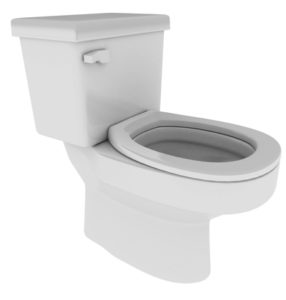
Toilet installation is no task to take lightly, friends. Your toilet is arguably a contender for most essential fixture in your home, ensuring (as it does) a very particular convenience you and your family would likely be hard-pressed to do without. And while it might be tempting for any number of reasons to go the DIY route, doing so often leads to major trouble down the line. Handy as one may be, there’s no substitute for specialized training or years of experience, and indeed, a layperson’s toilet installation can become a costly mistake—in more senses than one.
So, before you plunge elbow-deep into a toilet replacement project, read along below for some vital info on ensuring an all-around successful toilet installation.
Performance and Efficiency
When it comes to toilets, performance and efficiency matter. There are two main flushing mechanisms: gravity-fed and pressure-assisted. Gravity-fed toilets use as little as 10 PSI for flushing, but this inherently brings about a higher risk of clogging as waste removal is commensurately less… forceful. Pressure-assisted toilets, on the other hand, generate up to 25 PSI of water pressure, and therefore more thorough/effective waste collection. However, they do tend to be much noisier, and cost more to install.
Utility Bills
Toilets are major contributors to your home’s water consumption, accounting for 25 to 30 percent of water usage in the average American household. Older toilets with seven-gallon tanks can use around 13,000 gallons per year. Upgrading to a newer 1.28-gallon tank model can cut this down to approximately 2,300 gallons annually. Switching to an efficient toilet can save you up to 10,000 gallons of water per year—leading to substantial savings on your water bill as well.
Bowl Shape
Primarily, toilet bowls are either of the round or ovular variety. Oval-shaped bowls are versatile and can well accommodate a wide range of hypothetical individual needs. However, keep in mind that an oval shape might require more space in your bathroom. Comfort, ease of use/accessibility, and aesthetics are all vital considerations to make—but all are moot if you pick something that can’t physically fit where you need it to.
Seat Height
Toilet seat height can vary, but standard models come to around 14.5 inches. Some are designed for taller individuals, reaching about 16 inches in height, while handicap-rated units can range from 17 to 19 inches. -It’s crucial to choose a seat height that ensures ideal comfort and safety for all members of your household.
Space
As mentioned, a “successful” toilet installation requires adequate space. Most bathrooms need at least 15 inches of space from the center to the wall and a minimum of two feet of clearance in front of the toilet. While these dimensions might be sufficient for tight spaces, having around 30 inches of space in front of the toilet can create an open, non-cramped atmosphere. -Consider the elbow room you’d need to, say, comfortably read a newspaper or magazine.
All of Your Plumbing Needs from Master Plumbing
Give Master Plumbing a call at (301) 650-9100 or contact us online to get more information on how our expert plumbers can help you with just about anything plumbing-related! We have received Angie’s List Super Service Award recognition for plumbing and drain cleaning every year since 2007, in addition to the Best Plumber award from Best of Bethesda. We are fully licensed, bonded, and insured, and our service is unparalleled. Give us a call today—you won’t regret it! To see examples of our projects, follow us on Facebook, Twitter, and Pinterest.
